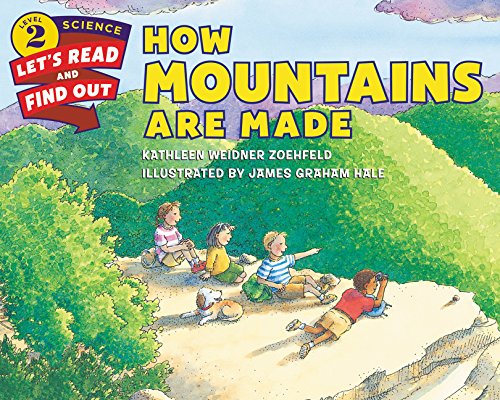On this page: General Resources | Earth’s History & Tectonics | Volcanoes | Earthquakes | Oceans | Mountains | Rivers | Biographies | Experiments
geology
📖 The Magic School Bus Inside the Earth by Joanna Cole & Bruce Degen. When the magic school bus takes them on a journey through the center of the earth, Ms. Frizzle's classroom has the chance to learn all about rocks, soil, caves, fossils, volcanoes, and the composition of the earth. For a classic picture book based on this same premise, see Faith McNulty's How to Dig a Hole to the Other Side of the World. – Preschool • Elementary
📖 Let's Go Rock Collecting by Roma Gans. This Stage 2 Let's-Read-and-Find-Out Science book provides a decent introduction to rocks—how they're formed, how they're classified, and how we use them. – Preschool • Elementary
📖 Grand Canyon by Jason Chin. Chin’s masterful award-winning Grand Canyon makes an excellent addition to a study of geology. Enjoy the breathtaking panoramic scenes while learning about the flora and fauna of the Grand Canyon, the formation of the canyon through the process of erosion, the passage of geological time, and much more. Highly recommended – Elementary • Middle
🖐️ Rock Tumbler. Kids who are serious about their rock collections may enjoy having a rock tumbler to polish and shine their stones. There are many different levels of tumbler available; one important consideration is noise – tumblers are pretty loud and run continuously for days, so it helps to have a basement or other out-of-the-way place to operate the device (higher-end tumblers will be quieter). The linked option is for a mid-range hobby tumbler from National Geographic. – All
▶️ Why is it hot underground? from MinuteEarth. Here is a brief introduction to the composition of Earth. – All
▶️ Everything you need to know about planet Earth from Kurzgesagt. “Planet Earth is this solid thing you are standing on right now. In your everyday life you don't really waste a thought about how amazing this is. A giant, ancient, hot rock. How did it come into existence and how big is it really? You will be surprised. The ground you are standing on is just a very, very small part of the big picture.” – All
▶️ Inside the Earth animation "A section of our planet Earth to display crust, mantle, outer and inner core." – All
earth’s history & tectonics
📖 When Planet Earth Was New by James Gladstone. Here’s a poetic introduction to Earth’s geologic and evolutionary history. A nice, simple accompaniment to a geology or evolution study. – Preschool • Elementary
📖 Earth! My First 4.54 Billion Years by Stacy McAnulty. Earth (aka ‘Planet Awesome’) tells us its story in this “Our Universe” book. True to form, McAnulty’s Earth is clever, well-illustrated, and packed with a surprising amount of information about the history and geology of Planet Earth. A fast, fun read. Also check out the other books in the series: Moon! and Sun! – Elementary
📖 Older Than Dirt: A Wild but True History of Earth by Don Brown and Michael Perfit. This excellent, humorous graphic book takes readers through the history of Earth, from the Big Bang to today: “Almost 14.5 billion years ago, it all started with a BIG BANG and what began as a cloud of gas, dust, and rock eventually took shape and bloomed into a molten sphere. Battered by asteroid collisions, ice ages, and shifting tectonic plates, our fledgling planet finally pushed forth continents. But if you think the earth has calmed down since then—think again! Geological activity continues to sculpt the earth’s landscape, sometimes with terrible consequences for its inhabitants: earthquakes, volcanoes, and tsunamis.” Highly recommended. – All
🔗 Content Connection: Evolution. Learn how life arose on early Earth.
💻 Travel through deep time from Smithsonian Magazine. Explore features of the planet at nine points in time—from 4 billion years in the past to 100 million years in the future. – All
💻 Global plate reconstruction from UCSD. The simple animation shows continental drift from 600 million years ago to today. – All
▶️ The dust bunnies that built our planet from TED-Ed. “Consider the spot where you’re sitting. Travel backwards in time and it might’ve been submerged at the bottom of a shallow sea, buried under miles of rock or floating through a molten landscape. But go back about 4.6 billion years, and you’d be in the middle of an enormous cloud of dust and gas orbiting a newborn star. What exactly is this cosmic dust?” – All
▶️ Four ways to understand the Earth’s age from TED-Ed. "The Earth is 4.6 billion years old—but how can humans relate to a number so colossal, and where do we fit on the geologic timeline? Comparing the Earth's lifetime to one calendar year, events like the extinction of dinosaurs and Columbus setting sail took place relatively recently. Joshua M. Sneideman reminds us of our time and place in the universe." – All
▶️ How to Date a Planet from MinuteEarth. Learn how scientists are able to estimate the age of Earth's first rocks. – All
▶️ Plate tectonics explained from MinuteEarth. "How do plate tectonics REALLY work?" – All
▶️ How North America got its shape from TED-Ed. “North America didn’t always have its familiar shape, nor its famed mountains, canyons, and plains: all of that was once contained in an unrecognizable mass, buried deep in Rodinia, a huge supercontinent that lay on the face of the Earth. Peter J. Haproff explains how it took millions of years and some incredible plate tectonics to forge the continent we know today.” – All
▶️ What happens when continents collide? from TED-Ed. “Tens of millions of years ago, plate tectonics set North and South America on an unavoidable collision course that would change the face of the Earth and spell life or death for thousands of species. Juan D. Carrillo explains the massive biological repercussions of this collision, which caused one of the greatest episodes of biological migration in history: The Great American Biotic Interchange” – All
volcanoes
📖 Volcanoes by Franklin M. Branley. This Stage 2 Let's-Read-and-Find-Out Science title discusses notable historic volcanic eruptions, from Vesuvius to Mount St. Helens, and explains what causes an eruption. Instructions for making your own volcano are included at the back. – Preschool • Elementary
📖 Volcano Rising by Elizabeth Rusch. While most people view volcanoes as primarily destructive forces, Volcano Rising draws attention to the ways in which volcanoes can serve as creative forces. Susan Swan's unusual illustrations really enhance the book. The text is simple enough for elementary kids, but the content will also hold the interest of older students. – Elementary • Middle
📖 Volcanoes by Seymour Simon. The highlight of a Seymour Simon book is always the excellent photography and Volcanoes is no exception. Alongside the stunning photographs, you will find plenty of historical and scientific information about volcanoes. – Elementary • Middle
📖 Eruption!: Volcanoes and the Science of Saving Lives by Elizabeth Rusch. "In this riveting nonfiction book—filled with spectacular photographs and sidebars—Rusch reveals the perilous, adrenaline-fueled, life-saving work of an international volcano crisis team (VDAP) and the sleeping giants they study, from Colombia to the Philippines, from Chile to Indonesia." Though well-written, this entry in the Scientists in the Field series is quite dense. – Middle
🔗 Content Connection: Ancient Rome. Learn about history’s most notorious volcanic eruption – Pompeii.
▶️ What makes volcanoes erupt? from TED-Ed. Here’s a nicely detailed explanation of the science behind volcanic eruptions: “In February of 1942, Mexican farmer Dionisio Pulido thought he heard thunder coming from his cornfield. However, the sound wasn’t coming from the sky. The source was a large, smoking crack emitting gas and ejecting rocks, and would come to be known as the volcano Paricutin. Where do new volcanoes like this come from, and what triggers their unpredictable eruption?” – All
▶️ The colossal consequences of supervolcanoes from TED-Ed. "Alex Gendler describes the history and science of these epic eruptions." – All
earthquakes
📖 Earthquakes by Seymour Simon. This title from Seymour Simon is characteristically well-written and informative; however, many of the images depict the brutal devastation that an earthquake can cause. Pre-screen for a sensitive child. – Elementary • Middle
▶️ Why are earthquakes so hard to predict? from TED-Ed. “In 132 CE, Zhang Heng presented his latest invention: a large vase he claimed could tell them whenever an earthquake occurred for hundreds of miles. Today, we no longer rely on pots as warning systems, but earthquakes still offer challenges to those trying to track them. Why are earthquakes so hard to anticipate, and how could we get better at predicting them?” – All
oceans
📖 Tracking Trash: Flotsam, Jetsam, and the Science of Ocean Motion by Loree Griffin Burns. This entry in the Scientist-in-the Field series introduces oceanographer Curtis Ebbesmeyer and his use of trash to study the movement of the ocean. – Middle
🔗 Content Connection: Ocean Life. Learn about the creatures that inhabit Earth’s oceans.
▶️ How do ocean currents work? from TED-Ed. “In 1992, a cargo ship carrying bath toys got caught in a storm. Shipping containers washed overboard, and the waves swept 28,000 rubber ducks and other toys into the North Pacific. But they didn’t stick together—the ducks have since washed up all over the world. How did this happen? Jennifer Verduin dives into the science of ocean currents.” – All
▶️ The Gulf Stream explained from Kurzgesagt. “The global conveyer belt is part of the large-scale ocean circulation that is driven by differences in the density of the waters. It plays a key role in keeping the climate at balance and Europe warm. Global warming may change it forever with unforeseeable consequences.” – Middle • High
▶️ How big is the ocean? from TED-Ed. “While the Earth’s oceans are known as five separate entities, there is really only one ocean. So, how big is it? As of 2013, it takes up 71% of the Earth, houses 99% of the biosphere, and contains some of Earth’s grandest geological features. Scott Gass reminds us of the influence humans have on the ocean and the influence it has on us.” – All
mountains
📖 How Mountains Are Made by Kathleen Weidner Zoehfeld. Through clear text and useful diagrams, Zoehfeld and Hale effectively, if simplistically, introduce the basic geological concepts of tectonic plate theory, the composition of the earth, and—as the title promises—how mountains are made. – Preschool • Elementary
▶️ How Tall Can Mountains Be? from MinuteEarth. "What is the maximum height for a mountain on Earth? And why?" – All
rivers
▶️ Why Do Rivers Have Deltas? from MinuteEarth. "Where rivers meet the ocean, coastlines tend to bend either inward or outward, creating estuaries and deltas. But how do they get those shapes?" – All
▶️ Why Do Rivers Curve? from MinuteEarth. Scientific explanation for meandering rivers and oxbow lakes. – All
scientist biographies
📖 Solving the Puzzle under the Sea: Marie Tharp Maps the Ocean Floor by Robert Burleigh. Here is the story of Marie Tharp who, along with fellow geologist Bruce Heezen, mapped the floor over the ocean and made important contributions to plate tectonic theory. It’s a simple retelling without too much detail; the endnotes include a biography and glossary. – Elementary
experiments
🖐️ Experiment with geology. Janice Van Cleave’s Earth Science for Every Kid is packed with experiments to enrich a Geology unit. Explore Rocks and Minerals in Unit II, Crustal Movement in Unit III, and Erosion in Unit IV. – Elementary
🖐️ Participate in Citizen Science. Search the SciStarter database to find projects appropriate for your child’s age and interests. Typical Geology-based projects include monitoring local water quality, collecting soil samples, and transcribing specimen labels of Cambrian fossils (online). – All
🖐️ Grow stalactites. In this lab from Steve Spangler Science, you will create cave pillars using washing soda. – All






















